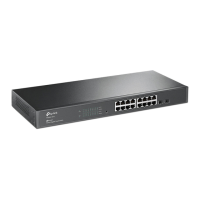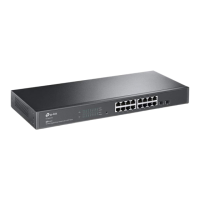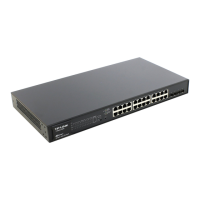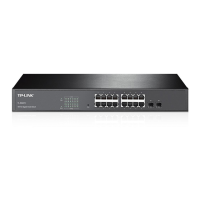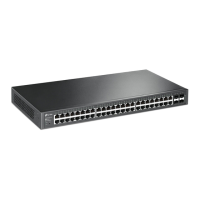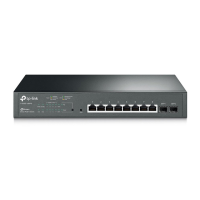Do you have a question about the TP-Link T1600G-52TS and is the answer not in the manual?
Information for network managers familiar with IT concepts and network terminologies.
Notices on how features may vary by model/software version and that images/descriptions are examples.
Links to download center, installation guide, product specifications, community, and technical support.
Choosing between Standalone Mode or Controller Mode for switch management based on network situation.
Accessing the switch's web interface through web-based authentication using HTTP or HTTPS server.
Accessing the switch's command line interface through console, Telnet, or SSH connection.
Viewing system summary, configuring device description, system time, and daylight saving time.
Creating and managing user accounts for login with different access levels (Admin, Operator, Power User, User).
Configuring boot file, restoring/backing up configurations, upgrading firmware, rebooting, and resetting the switch.
Configuring PoE parameters manually or using profiles for supported devices.
Prioritizing hardware resources for features by selecting from three templates for different usage scenarios.
Configuring time ranges that can be used when configuring other features like ACL.
Configuring port status, speed mode, duplex mode, flow control, and other basic parameters for ports.
Restricting data transmitted by a port to only communicate with specified ports in the forwarding port list.
Detecting loops in the network and blocking the port or VLAN if a loop is detected.
Provides examples for configuring physical interfaces, such as port isolation and loopback detection.
Configuring the global load-balancing algorithm and static LAG or LACP.
Examples for configuring static LAG and LACP, including network requirements and configuration schemes.
Overview of the MAC address table and supported features like dynamic, static, and filtering addresses.
Adding static MAC address entries, changing aging time, adding filtering entries, and viewing address table entries.
Configuring VLANs, including creating a VLAN and adding ports, and configuring port parameters for 802.1Q VLAN.
Example of configuring VLANs and ports for inter-departmental communication.
Binding MAC addresses to VLANs and enabling MAC VLAN for ports.
Example of configuring MAC VLAN to assign IP addresses based on MAC addresses.
Configuring 802.1Q VLAN, creating protocol templates, and configuring Protocol VLAN groups.
Example of configuring Protocol VLAN to forward IPv4 and IPv6 packets to respective networks.
Creating VLANs, enabling GVRP globally, and configuring GVRP on each port.
Example of configuring GVRP for dynamic VLAN configuration and management.
Enabling IGMP Snooping globally, for VLANs, and for ports.
Enabling MLD Snooping globally, for VLANs, and for ports.
Configuring 802.1Q VLANs, MVR globally, multicast groups, and ports for MVR.
Creating multicast profiles and configuring multicast groups a port can join.
Examples for configuring IGMP Snooping, MVR, and Multicast Filtering.
Configuring STP/RSTP parameters on ports and globally, and verifying configurations.
Configuring parameters on ports in CIST, the MSTP region, and globally.
Configuring security features like Loop Protect, Root Protect, BPDU Protect, BPDU Filter, and TC Protect.
Example of configuring MSTP for load balancing across different paths.
Configuring LLDP feature globally and for ports.
Configuring LLDP-MED feature globally and for ports.
Example of configuring LLDP globally and on specific ports.
Creating Layer 3 interfaces (VLAN, Loopback, Routed, Port-channel) and configuring IPv4/IPv6 parameters.
Example of configuring VLAN interfaces for hosts to access the internet.
Configuring static routes for IPv4 by specifying destination, subnet mask, next hop, and distance.
Configuring static routes for IPv6 by specifying destination, prefix length, next hop, and distance.
Viewing IPv4 and IPv6 routing tables to learn about network topology and connectivity.
Example of configuring static routes to enable communication between different network segments.
Enabling DHCP Server, configuring pools, and manually assigning static IP addresses.
Configuring DHCP Relay, Option 82, Interface Relay, and VLAN Relay.
Enabling DHCP L2 Relay and configuring Option 82 for ports.
Examples for DHCP Server, DHCP Interface Relay, and DHCP VLAN Relay configurations.
Viewing ARP entries, adding static entries, configuring Gratuitous ARP, and configuring Proxy ARP.
Default parameters for ARP configurations.
Configuring port priority, 802.1p priority, DSCP priority, and scheduler settings.
Configuring rate limit and storm control to ensure network performance.
Creating 802.1Q VLAN, configuring OUI addresses, voice VLAN globally, and adding ports.
Configuring Auto VoIP globally and on ports, and optimizing voice traffic.
Examples for configuring Class of Service, Voice VLAN, and Auto VoIP.
Configuring Access Control, HTTP, HTTPS, SSH, and Telnet features.
Default settings for Access Security features.
Adding servers, configuring server groups, method lists, and application lists.
Example of configuring AAA using RADIUS servers for authentication.
Default parameters for AAA configurations.
Configuring RADIUS server, 802.1x globally, and 802.1x on ports.
Example of configuring 802.1x authentication with RADIUS server.
Default settings for 802.1x authentication.
Configuring port security parameters like max learned MAC addresses, learn mode, and status.
Default parameters for Port Security.
Creating ACLs (MAC, IP, Combined, IPv6) and configuring rules, policy, and binding.
Examples for configuring MAC ACL, IP ACL, Combined ACL, and IPv6 ACL.
Default parameters for ACL configurations.
Adding IP-MAC binding entries manually, via ARP Scanning, or via DHCP Snooping.
Enabling ARP Detection globally, for VLANs, and on ports.
Configuring IPv4 Source Guard to filter IPv4 packets based on IP-MAC Binding table.
Examples for configuring ARP Detection and IPv4 Source Guard.
Adding IPv6-MAC binding entries manually, via ND Snooping, or via DHCPv6 snooping.
Enabling ND Detection globally, for VLANs, and on ports.
Configuring IPv6 Source Guard to filter IPv6 packets based on IPv6-MAC Binding table.
Examples for configuring ND Detection and IPv6 Source Guard.
Configuring basic DHCPv4 filter parameters and legal DHCPv4 servers.
Configuring basic DHCPv6 filter parameters and legal DHCPv6 servers.
Examples for configuring DHCPv4 Filter and DHCPv6 Filter.
Configuring various defend types against DoS attacks like Land Attack, SYN Flood, Ping Flooding etc.
Default parameters for DoS Defend configuration.
Monitoring CPU utilization of the switch using GUI or CLI.
Monitoring memory utilization of the switch using GUI or CLI.
Monitoring port traffic information, including traffic summary and statistics.
Sending a copy of traffic passing through specified sources to a destination port for analysis.
Configuring Device Link Detection Protocol to detect unidirectional links.
Configuring SNMP and RMON for network monitoring and management.
Troubleshooting network issues using Ping and Tracert tests.
Configuring local and remote logs, backing up logs, and viewing the log table.
Configuring DLDP globally and on ports, including advertisement interval and shutdown mode.
Default parameters for DLDP configuration.
Enabling SNMP, creating SNMP views, communities, groups, and users.
Configuring NMS hosts, enabling SNMP traps (standard and extended).
Configuring Statistics, History, Event, and Alarm groups for network monitoring.
Example of configuring SNMP and RMON for network monitoring and trap notifications.
Default parameters for SNMP and RMON configurations.
Using cable testing feature for troubleshooting based on connection status, length, and fault location.
Using Ping and Tracert tools to test connectivity to remote hosts, gateways, and along the path.
Default parameters for Network Diagnostics features.
Configuring local logs (buffer/file), remote logs, backing up logs, and viewing log table.
Example of configuring local logs to save messages to buffer and flash.
Default settings for System Logs configurations.
Information for network managers familiar with IT concepts and network terminologies.
Notices on how features may vary by model/software version and that images/descriptions are examples.
Links to download center, installation guide, product specifications, community, and technical support.
Choosing between Standalone Mode or Controller Mode for switch management based on network situation.
Accessing the switch's web interface through web-based authentication using HTTP or HTTPS server.
Accessing the switch's command line interface through console, Telnet, or SSH connection.
Viewing system summary, configuring device description, system time, and daylight saving time.
Creating and managing user accounts for login with different access levels (Admin, Operator, Power User, User).
Configuring boot file, restoring/backing up configurations, upgrading firmware, rebooting, and resetting the switch.
Configuring PoE parameters manually or using profiles for supported devices.
Prioritizing hardware resources for features by selecting from three templates for different usage scenarios.
Configuring time ranges that can be used when configuring other features like ACL.
Configuring port status, speed mode, duplex mode, flow control, and other basic parameters for ports.
Restricting data transmitted by a port to only communicate with specified ports in the forwarding port list.
Detecting loops in the network and blocking the port or VLAN if a loop is detected.
Provides examples for configuring physical interfaces, such as port isolation and loopback detection.
Configuring the global load-balancing algorithm and static LAG or LACP.
Examples for configuring static LAG and LACP, including network requirements and configuration schemes.
Overview of the MAC address table and supported features like dynamic, static, and filtering addresses.
Adding static MAC address entries, changing aging time, adding filtering entries, and viewing address table entries.
Configuring VLANs, including creating a VLAN and adding ports, and configuring port parameters for 802.1Q VLAN.
Example of configuring VLANs and ports for inter-departmental communication.
Binding MAC addresses to VLANs and enabling MAC VLAN for ports.
Example of configuring MAC VLAN to assign IP addresses based on MAC addresses.
Configuring 802.1Q VLAN, creating protocol templates, and configuring Protocol VLAN groups.
Example of configuring Protocol VLAN to forward IPv4 and IPv6 packets to respective networks.
Creating VLANs, enabling GVRP globally, and configuring GVRP on each port.
Example of configuring GVRP for dynamic VLAN configuration and management.
Enabling IGMP Snooping globally, for VLANs, and for ports.
Enabling MLD Snooping globally, for VLANs, and for ports.
Configuring 802.1Q VLANs, MVR globally, multicast groups, and ports for MVR.
Creating multicast profiles and configuring multicast groups a port can join.
Examples for configuring IGMP Snooping, MVR, and Multicast Filtering.
Configuring STP/RSTP parameters on ports and globally, and verifying configurations.
Configuring parameters on ports in CIST, the MSTP region, and globally.
Configuring security features like Loop Protect, Root Protect, BPDU Protect, BPDU Filter, and TC Protect.
Example of configuring MSTP for load balancing across different paths.
Configuring LLDP feature globally and for ports.
Configuring LLDP-MED feature globally and for ports.
Example of configuring LLDP globally and on specific ports.
Creating Layer 3 interfaces (VLAN, Loopback, Routed, Port-channel) and configuring IPv4/IPv6 parameters.
Example of configuring VLAN interfaces for hosts to access the internet.
Configuring static routes for IPv4 by specifying destination, subnet mask, next hop, and distance.
Configuring static routes for IPv6 by specifying destination, prefix length, next hop, and distance.
Viewing IPv4 and IPv6 routing tables to learn about network topology and connectivity.
Example of configuring static routes to enable communication between different network segments.
Enabling DHCP Server, configuring pools, and manually assigning static IP addresses.
Configuring DHCP Relay, Option 82, Interface Relay, and VLAN Relay.
Enabling DHCP L2 Relay and configuring Option 82 for ports.
Examples for DHCP Server, DHCP Interface Relay, and DHCP VLAN Relay configurations.
Viewing ARP entries, adding static entries, configuring Gratuitous ARP, and configuring Proxy ARP.
Default parameters for ARP configurations.
Configuring port priority, 802.1p priority, DSCP priority, and scheduler settings.
Configuring rate limit and storm control to ensure network performance.
Creating 802.1Q VLAN, configuring OUI addresses, voice VLAN globally, and adding ports.
Configuring Auto VoIP globally and on ports, and optimizing voice traffic.
Examples for configuring Class of Service, Voice VLAN, and Auto VoIP.
Configuring Access Control, HTTP, HTTPS, SSH, and Telnet features.
Default settings for Access Security features.
Adding servers, configuring server groups, method lists, and application lists.
Example of configuring AAA using RADIUS servers for authentication.
Default parameters for AAA configurations.
Configuring RADIUS server, 802.1x globally, and 802.1x on ports.
Example of configuring 802.1x authentication with RADIUS server.
Default settings for 802.1x authentication.
Configuring port security parameters like max learned MAC addresses, learn mode, and status.
Default parameters for Port Security.
Creating ACLs (MAC, IP, Combined, IPv6) and configuring rules, policy, and binding.
Examples for configuring MAC ACL, IP ACL, Combined ACL, and IPv6 ACL.
Default parameters for ACL configurations.
Adding IP-MAC binding entries manually, via ARP Scanning, or via DHCP Snooping.
Enabling ARP Detection globally, for VLANs, and on ports.
Configuring IPv4 Source Guard to filter IPv4 packets based on IP-MAC Binding table.
Examples for configuring ARP Detection and IPv4 Source Guard.
Adding IPv6-MAC binding entries manually, via ND Snooping, or via DHCPv6 snooping.
Enabling ND Detection globally, for VLANs, and on ports.
Configuring IPv6 Source Guard to filter IPv6 packets based on IPv6-MAC Binding table.
Examples for configuring ND Detection and IPv6 Source Guard.
Configuring basic DHCPv4 filter parameters and legal DHCPv4 servers.
Configuring basic DHCPv6 filter parameters and legal DHCPv6 servers.
Examples for configuring DHCPv4 Filter and DHCPv6 Filter.
Configuring various defend types against DoS attacks like Land Attack, SYN Flood, Ping Flooding etc.
Default parameters for DoS Defend configuration.
Monitoring CPU utilization of the switch using GUI or CLI.
Monitoring memory utilization of the switch using GUI or CLI.
Monitoring port traffic information, including traffic summary and statistics.
Sending a copy of traffic passing through specified sources to a destination port for analysis.
Configuring Device Link Detection Protocol to detect unidirectional links.
Configuring SNMP and RMON for network monitoring and management.
Troubleshooting network issues using Ping and Tracert tests.
Configuring local and remote logs, backing up logs, and viewing the log table.
Configuring DLDP globally and on ports, including advertisement interval and shutdown mode.
Default parameters for DLDP configuration.
Enabling SNMP, creating SNMP views, communities, groups, and users.
Configuring NMS hosts, enabling SNMP traps (standard and extended).
Configuring Statistics, History, Event, and Alarm groups for network monitoring.
Example of configuring SNMP and RMON for network monitoring and trap notifications.
Default parameters for SNMP and RMON configurations.
Using cable testing feature for troubleshooting based on connection status, length, and fault location.
Using Ping and Tracert tools to test connectivity to remote hosts, gateways, and along the path.
Default parameters for Network Diagnostics features.
Configuring local logs (buffer/file), remote logs, backing up logs, and viewing log table.
Example of configuring local logs to save messages to buffer and flash.
Default settings for System Logs configurations.
| Switch type | Managed |
|---|---|
| Switch layer | L2+ |
| ARP inspection | Yes |
| Power connector | DC-in jack |
| SFP module slots quantity | 4 |
| Installed SFP modules quantity | 0 |
| Basic switching RJ-45 Ethernet ports type | Gigabit Ethernet (10/100/1000) |
| Basic switching RJ-45 Ethernet ports quantity | 48 |
| 10G support | No |
| Networking standards | IEEE 802.1D, IEEE 802.1Q, IEEE 802.1p, IEEE 802.1s, IEEE 802.1w, IEEE 802.3ab, IEEE 802.3i, IEEE 802.3u, IEEE 802.3x, IEEE 802.3z |
| Copper ethernet cabling technology | 10BASE-T, 100BASE-TX, 100BASE-T, 1000BASE-T |
| Throughput | 77.4 Mpps |
| Jumbo frames | 9216 |
| MAC address table | 16000 entries |
| Security algorithms | SSH, SSL/TLS |
| Stackable | - |
| Form factor | 1U |
| Certification | CE, FCC, RoHS |
| Product color | Black |
| AC input voltage | 100 - 240 V |
| AC input frequency | 50 - 60 Hz |
| Power consumption (typical) | 32.8 W |
| Storage temperature (T-T) | -40 - 70 °C |
| Operating temperature (T-T) | 0 - 40 °C |
| Storage relative humidity (H-H) | 5 - 90 % |
| Operating relative humidity (H-H) | 10 - 90 % |
| Cables included | AC |
| Depth | 220 mm |
|---|---|
| Width | 440 mm |
| Height | 44 mm |

